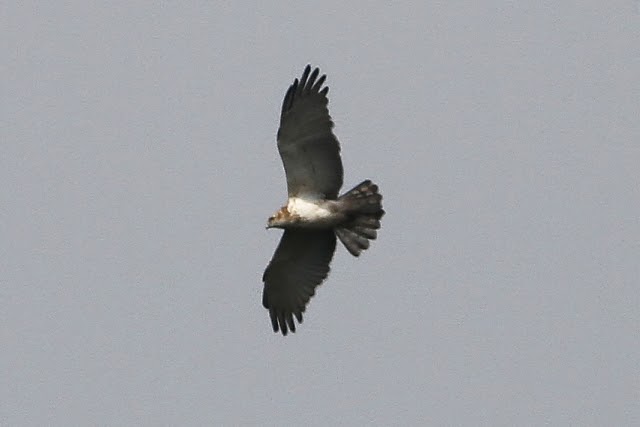Something of a pattern emerging here in recent years: enforced camping trips made almost bearable by good birding nearby. First the
New Forest, then
North Norfolk and, last weekend, a gathering of the in-laws at High Ham. This is deep in the flat, wet bit of Somerset, and a short hop from the complex of nature reserves in the area now known as the Avalon Marshes. Poetic, perhaps; historically inaccurate, almost certainly.
 |
| Bittern: all photos taken from public hides and viewpoints at Ham Wall RSPB. Sit, wait, and enjoy the best airshow of the summer. |
Still, churlish to complain about cheesy names when they've done such a good job of it - they being the RSPB, Natural England, the Somerset Wildlife Trust and the Environment Agency among others. A proper bit of landscape-scale conservation, this: no mucking about with a pokey little, fenced-off nature reserve: no, siree - this is restoration of a vast area of denuded peatlands to glorious wetland on a grand scale. More breeding Bitterns than you can shake a stick at - rising from a small proportion to around half the UK's booming males in less than a decade (see
here for graphs and stuff) - and swarms of dragonflies which give some idea of what hyper-abundance must have looked like back in the day. For those who doubt people can ever do much good for birds, this is not a bad place to look for encouragement. I headed straight for the RSPB reserve at Ham Wall, with its well positioned hides and viewing platforms, from which a keen-eyed volunteer warden was pointing out passing Bitterns with surprising regularity.
 |
| Bittern: check out the photos on the recent sightings page of the Ham Wall blog of four in flight together last month |
The camping itself was, of course, intolerable, and made only slightly less so by the presence of Uncle Andy, my brother-in-law, the only other member of the extended family who hates camping more than I. Taller than me with feet hanging even more over the end of his rapidly deflating airbed, he found it so traumatic he was having flashbacks to Kosovo where he served a difficult tour with the RAF.
 |
| Bittern at Ham Wall |
The location was not a campsite as such, but a freshly mown hay meadow (not great for the hay-fever, it turned out) attached to a farmhouse owned by a friend of the family. While this meant we were spared the usual background noise of a proper campsite, it also meant sharing just the one chemical toilet, which had a festival feel to it by the end of the weekend. And not in a good way.
 |
| Great White Egret: the volunteer warden said they don't breed at Ham Wall but are regular visitors throughout the year. |
One of the iron laws of camping was upheld: namely, no matter how many airbeds you take, precisely one less than you need will remain unpunctured. Fortunately I had a self-inflating mattress procured for twitching emergencies which saved one of the children from sleeping on a cold hard floor. Well I wasn't going to give up my airbed, was I?
 |
| Great White Egret: a flyover shortly after my arrival, in contrast to the elusive bird in Poole Harbour recently. |
Over the course of about 36 hours, I estimate approximately 4 hours of decent sleep were snatched; another 4 involved pretending to sleep; perhaps 2 were spent actually relaxing in a deck chair; and the rest consumed by packing, unpacking, assembling, dismantling, packing and unpacking again. Surviving on a strict diet of barbecued food, the onset of scurvy threatened, so we drank as much alcohol as we could find, purely for its antiseptic properties, you understand...
 |
| Four-spotted Chaser was the most abundant dragonfly at Ham Wall - and what an abundance |
Before being allowed home to indulge such outrageous luxuries as running water and walls, however, we were all gathered in a circle for tributes and a raffle (a regular feature of the camping trips which it would appear are a tradition in the extended family - a fact I certainly don't recall being disclosed before I took my wedding vows).
 |
| Banded Demoiselle - this one a striking male. Very few biting insects at Ham Wall: they were all in my tent up the road. |
As we sat in the ring, we were welcomed among the other 'first timers'. I thought 'what do you mean
first timers? How about
last?', but what with the sleep deprivation and the heat, apparently I thought this aloud. I think I got away with it though as it was muffled by Uncle Andy's guffawing at having exactly the same thought at that moment. More guffawing when first prize in the raffle was drawn - you guessed it - a one week camping holiday. Thankfully, neither of us held the winning ticket.
 |
| Blue-tailed Damselflies. Get a room! |
As his reward for turning up, this coming weekend Uncle Andy gets to go to Brazil and watch the World Cup. I get to go, er, camping again, back to the New Forest. Must have done something
very wrong in a previous life...
 |
| Glastonbury Tor: the Avalon of Arthurian legend where the wounded King was taken to recover after the Battle of Camlann: an island sitting above the marshlands of what we now know as the Somerset Levels. |
 |
| A wider angle view from the living hell of the campsite. |













+Worth+Matravers,+Dorset.JPG)








































